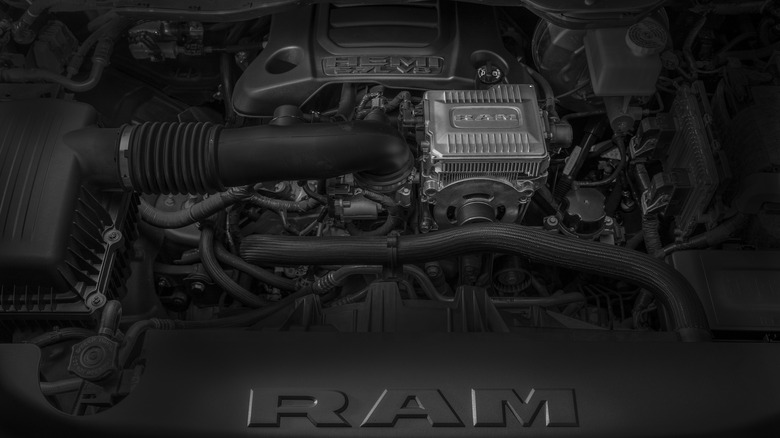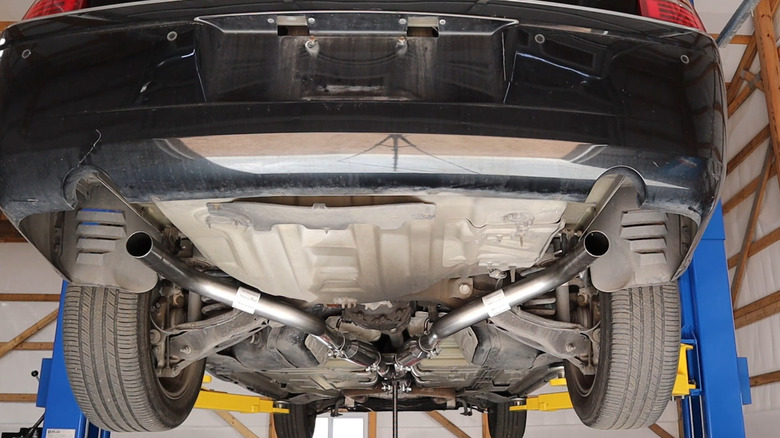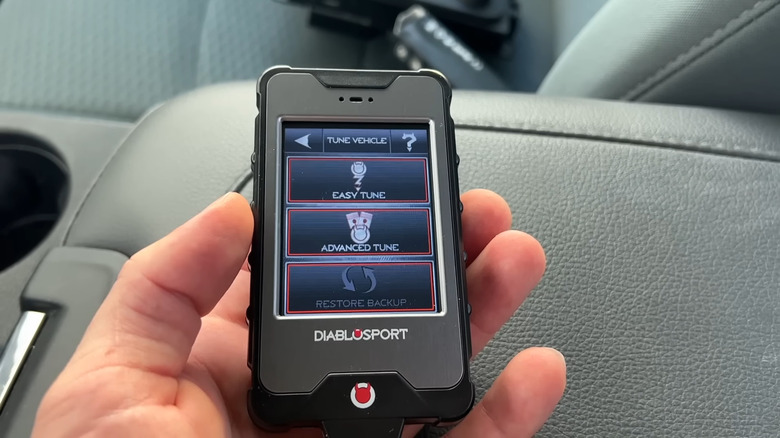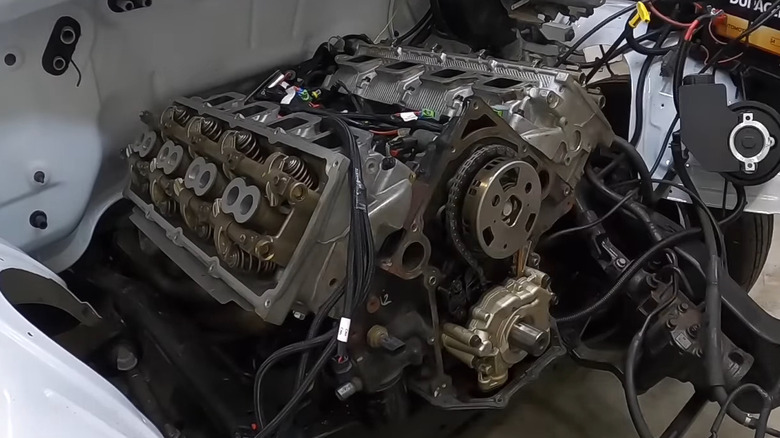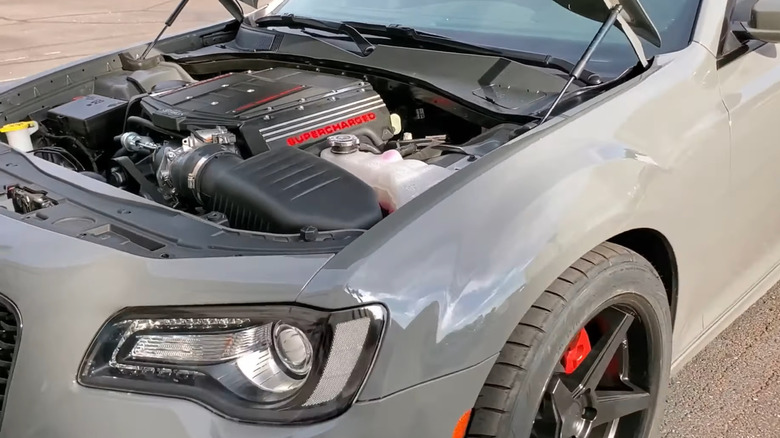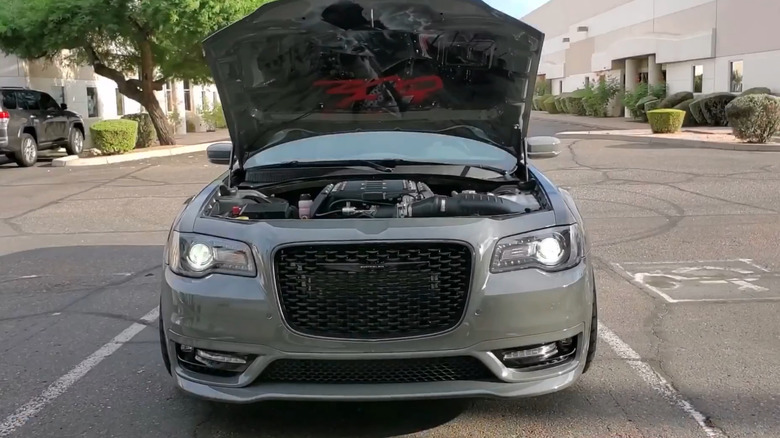5 Additions That Could Upgrade Your 5.7L Hemi Engine's Performance
We may receive a commission on purchases made from links.
The 5.7-liter Hemi was the first engine of Chrysler's modern Gen III V8 family, introduced in the 2003 Ram trucks. Since then, it has been used on regular cars as well, like the Chrysler 300C, Dodge Durango, Magnum R/T, Charger, and Jeep Grand Cherokee. The 5.7-liter Hemi is also sold as a crate engine today, making it an enticing option for project car builders. It's so popular, Ram returned it in the latest 1500 truck in "eTorque" mild hybrid form.
Consisting of a cast iron block, aluminum head, lightweight aluminum, skirt-coated pistons, and forged connecting rods, it has proven to be a reliable unit. This has made the 5.7-liter Hemi a popular project engine among Mopar enthusiasts, with many aftermarket companies producing parts and kits for increased performance.
But what are the best additions for horsepower gains on your 5.7-liter Hemi? Several different routes can extract more performance. Do you want a naturally aspirated build, or would you prefer the forced-induction for some tire-shredding horsepower numbers? Or maybe you want a track-ready 5.7-liter Hemi that will consistently deliver high horsepower. This piece has it all, explained in layman's terms and with expected horsepower gains.
Before we start, it's worth noting that for high-horsepower builds, it would be necessary to also replace most internal parts. The factory pistons, rods, and crankshaft of the 5.7-liter Hemi can only handle up to 650 hp, so going north of that will require tougher forged components. With that settled, let's dig in!
Performance exhaust system
Aftermarket exhaust systems are a very popular upgrade among owners of the 5.7-liter Hemi engine. However, most people opt for cat-back exhausts because they enhance the already excellent sound even further. Louder. Deeper. More satisfactory.
However, a more comprehensive system could upgrade your 5.7L Hemi's performance. How? Well, by utilizing a whole branch of science called fluid dynamics — in this case, exhaust gases. See, most people think that a wider-diameter tubing will let the engine breathe better and therefore increase horsepower. This is true, but a smaller-diameter tube can also accelerate the exhaust gases, which can also be beneficial. There is also the term scavenging, which creates vacuum from the exhaust pulses, helping the engine draw air into the combustion chamber. More oxygen equals more power.
For all these reasons, it's crucial to choose the correct size exhaust for your 5.7-liter Hemi application. Wider diameter pipes provide horsepower gains at higher rpm. Meanwhile, smaller diameter pipes make the engine more responsive at lower rpm. Yup, this means it takes a lot of engineering to get the performance right, which is why you'd want to buy from reputable companies, like MagnaFlow, Borla, and Kooks Headers.
Also, you can change different parts of the exhaust system, each bringing different horsepower gains. For instance, axle-back upgrades will only improve the sound, while cat-back and header upgrades can improve power and torque. Header-back exhaust systems, though, replace the whole assembly, leading to the highest performance gains.
ECU tuning / reprogramming
Perhaps the easiest path to more horsepower is ECU tuning. As its name suggests, this upgrade modifies the engine control unit (ECU) using upgraded software maps specifically designed for the 5.7-liter Hemi engine. ECU tuning tweaks every parameter that could lead to power gains. Notably, it can adjust the air-to-fuel ratio and fuel injection/ignition timing to improve torque and power delivery.
On turbocharged engines, ECU tuning can also alter turbo boost, which can significantly increase power. However, the 5.7-liter Hemi is a naturally aspirated engine, so the gains won't be as significant — expect no more than 40 hp over the stock 395 hp. Still, combining ECU tuning with hardware upgrades could boost power figures even further. High-flow fuel injectors and fuel pumps will let tuners use more fuel to increase power and torque.
Even a 10% boost isn't insignificant, especially for a process that takes only a few hours. You could even do it yourself with the DiabloSport tuner that's specifically designed for the 5.7-liter Hemi engine and licensed. This plug-and-play solution connects directly to your vehicle's OBD-II port and even allows you to customize the tune. Still, while it works well for most users, some complained that it made their engine perform worse. So, if you are unsure about these things, it's highly advisable to take your vehicle to a reputable shop. There, you can also get a custom map that will better utilize any other upgrade you have on the engine.
High-performance camshaft
Camming a car brings the highest horsepower gains in naturally aspirated engines. This is particularly true for the 5.7-liter Hemi, because it has a free-flowing head and high-capacity intake, both of which help draw more air into the combustion chamber.
The camshaft controls the cam timing, lift, and lobe separation angle — basically, when and how much the intake/exhaust valves open, close, and overlap. Automakers usually put more conservative cams on engines, with smaller lift and shorter duration, which provides better low rpm performance, and is important for everyday drivability, smooth idling, mileage, and emissions. However, these camshafts starve the engine for air at higher revolutions, limiting power.
Install a high-performance camshaft, and your Hemi will become way more potent at higher revs. Hot Rod tested a 5.7-liter Hemi with the stock and high-performance camshafts and measured a significant 67-hp difference. Oh, and that was without any penalty on low-rpm torque, which is an issue for some cammed engines. VVT versions of the engine, introduced in 2009, where the cam duration changes with rpm, will have even smaller issues. Still, if you are concerned about that, some performance camshafts are designed to increase low-end torque and bring gains at the higher end (around 30 hp).
The best part about this upgrade is that it's relatively straightforward and doesn't require opening the engine. If you have mechanical knowledge, camming your 5.7-liter Hemi engine is even a DIY affair. Performance camshafts are also relatively inexpensive, ranging between $500 and $600.
Turbocharger or Supercharger Kits
If these double-digit gains leave you feeling cold, you may need to go the forced induction route path. Adding a supercharger or turbocharger to your 5.7-liter Hemi can bring outstanding performance gains, with Hellion's twin-turbo kit bringing the engine to a whopping 2,000 hp, all thanks to more air.
Superchargers and turbochargers literally force compressed air into the combustion chamber, which leads to a more potent combustion. Of course, more fuel is also necessary to achieve high horsepower gains, so installing a fuel controller and ECU recalibration is also necessary.
What's the difference between supercharging and turbocharging? It really depends on your usage scenario. Superchargers give smaller, though still significant, performance gains, but are also cheaper on average than turbochargers. Since they are driven by the engine's crankshaft, superchargers react quickly to any increase in rpm and produce no perceivable lag. In other words, your 5.7-liter Hemi will be as responsive as before, but with way more oomph.
Meanwhile, turbochargers run on engine exhaust gases and need to spool up to compress the intake air significantly. This creates turbo lag, i.e., an amount of time when the engine doesn't respond to the pedal input. Turbochargers are more efficient, though, and can lead to higher horsepower gains. So, if you are making a competitive 5.7-liter Hemi build, they make more sense. Conversely, supercharging is better-suited to street-oriented builds, where low-rpm responsiveness matters more than peak power.
Upgraded Cooling Systems
Engine cooling is an often-neglected upgrade when people talk about performance gains. Still, it's as important as any other upgrade. See, adding more power to any engine translates to more heat being produced. If you can't dissipate the extra heat, the engine will start to overheat and lose power. This will often happen when driving on track or while towing with the 5.7-liter Hemi engine, because the factory cooling solution doesn't have enough capacity to handle the additional heat. Overheating can lead to many issues, like failed piston rings, gaskets, and turbochargers.
Okay, but how does an upgraded cooling system help with performance? Well, that's easy — it allows you to fully utilize your tuned Hemi engine, even when pushing it to its limits. With a good cooling solution, the engine won't lose power on the track, while towing/hauling, or simply when it's too hot outside. So, yes, upgraded cooling system doesn't directly increase horsepower, but it allows you to use all of it, at any given moment.
The easiest way to increase cooling is by installing a performance radiator, like this Mishimoto MMRAD-RAM-04 that costs $599.95 on Amazon. Performance radiators have an increased coolant capacity and a larger contact area, which increases cooling performance. To maximize the radiator's potential, you might also want to invest in high-performance fans. Oil coolers will also keep your engine's temperature at check, like this MOPAR kit designed for police cars equipped with the 5.7-liter and 6.1-liter Hemi engines. Finally, an intercooler can lower the intake temperature to allow turbo kits extract more power.
